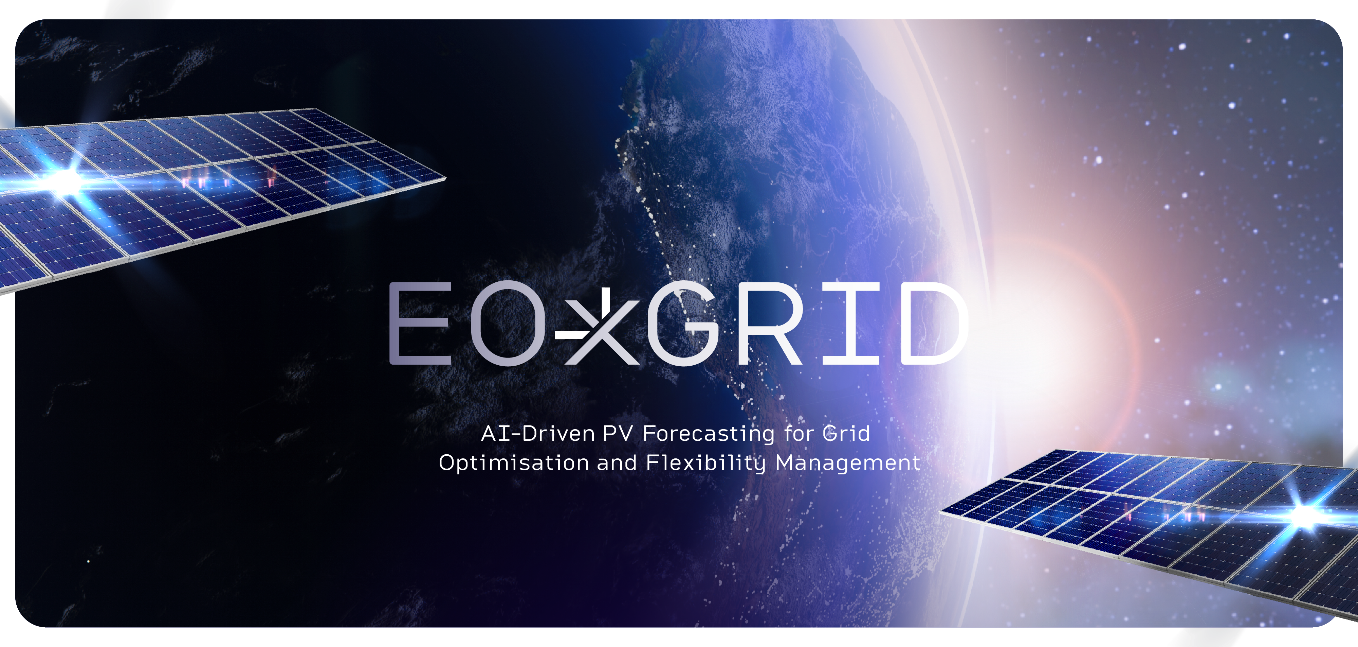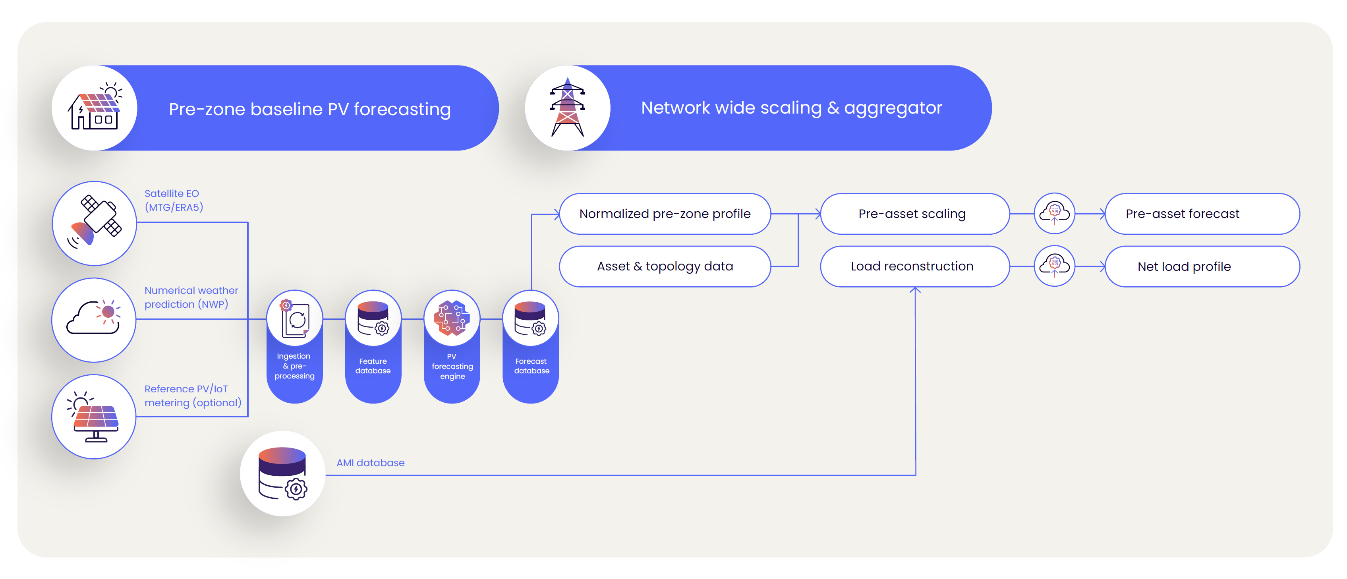
Objectives of the service

Electricity grid operators face mounting challenges in managing distributed solar energy, particularly due to limited visibility into behind-the-meter photovoltaic (PV) production and the lack of accurate short-term forecasts. These gaps hinder effective planning, real-time monitoring, and coordination with national transmission operators. Our service addresses these issues by delivering high-resolution PV generation forecasts and reconstructing true consumption profiles using satellite data, artificial intelligence models, and minimal reference sensors.
The solution integrates Earth observation imagery, numerical weather predictions, and grid metadata to produce feeder-level forecasts and load reconstructions without requiring costly hardware upgrades. It enables grid operators to optimize infrastructure investments, reduce imbalance penalties, and improve hosting capacity for renewable energy.
The activity is a feasibility study aimed at validating the technical and operational impact of these services through two use cases with a regional grid operator. It includes model development, stakeholder engagement, and business impact assessment, with the goal of preparing for scalable deployment across European electricity networks.
Users and their needs
The primary user community targeted by the service is electricity distribution system operators (DSOs), with Elektro Primorska in Slovenia serving as the representative user throughout the feasibility study. These operators manage regional electricity grids and face increasing challenges due to the rapid growth of distributed photovoltaic (PV) systems. Target markets are European Union markets.
User involved at DSOs:
-
Grid planning engineers
-
Operational analysts
-
Strategic development teams at DSOs
User Needs:
-
Accurate reconstruction of gross electricity consumption hidden by behind-the-meter PV production
-
Reliable short-term PV generation forecasts for unmonitored assets
-
Improved visibility of distributed energy resources without costly hardware upgrades
-
Enhanced data inputs for planning, state estimation, and coordination with national transmission operators
Project Challenges:
-
Integrating diverse datasets (satellite, weather, grid metadata) with limited historical measurements
-
Achieving high forecast accuracy across varied PV asset types and locations
-
Ensuring compatibility with existing grid management systems
-
Demonstrating regulatory and operational value to justify adoption
Service/ system concept
The EO x Grid service provides electricity grid operators with two key capabilities: (1) reconstruction of true electricity consumption hidden by rooftop solar systems, and (2) accurate short-term forecasts of photovoltaic (PV) generation across the grid. Users receive clean, time-stamped data streams showing gross load per customer and predicted solar output per asset, enabling better planning, real-time monitoring, and coordination with national transmission operators.
How it works:
The system collects satellite images, weather forecasts, and grid data. It uses artificial intelligence to estimate how much solar energy is being produced and adds that back to smart meter readings to reveal actual electricity use. It also predicts future solar output using updated weather data and reference sensors.
High-Level Architecture:
-
Data Inputs: Satellite imagery, weather forecasts, smart meter data, PV metadata
-
Processing Engine: Cleans and aligns data, runs forecasting models
-
Outputs: Load reconstruction and PV forecasts delivered via dashboards or APIs
Here’s a simplified diagram:
This modular setup ensures scalability, accuracy, and minimal hardware requirements.

Space Added Value
The EO x Grid service uses Earth observation data from two key space assets: EUMETSAT’s Meteosat satellites (MSG/MTG series) and the Copernicus Climate Data Store (CDS). These satellites provide high-frequency, high-resolution imagery and atmospheric variables such as cloud cover, solar radiation, and temperature—critical inputs for estimating and forecasting photovoltaic (PV) generation.
Added Value of Space Assets:
-
Temporal granularity: Meteosat delivers hourly updates, capturing rapid changes in irradiance that ground-based sensors or weather models often miss.
-
Spatial coverage: Satellite data ensures consistent visibility across all grid areas, including remote or unmonitored PV installations.
-
Cost-efficiency: Unlike hardware-heavy solutions, satellite data enables scalable forecasting without installing new sensors.
Why It Outperforms Competitors:
-
Most existing providers rely solely on weather models or limited ground sensors, which lack the precision and coverage needed for feeder-level forecasts.
-
EO x Grid combines satellite imagery with minimal reference sensors and AI models to reconstruct true consumption and predict PV output—delivering superior accuracy and operational relevance for grid operators.
This integration of space assets enables a meterless, scalable, and regulation-aligned solution for managing distributed solar energy.
Current Status
Between April and August 2025, the EO x Grid feasibility study completed five development sprints and six stakeholder workshops, including three co-design sessions with Elektro Primorska (EPR). Two use cases were finalized—gross load reconstruction and short-term PV forecasting—and validated through model development and business impact analysis. Over 260 satellite variables and 24 weather features were processed, with the best-performing models reducing forecast error by over 25% compared to baseline. A dedicated server and database were deployed to support scalable forecasting. Workshops with EPR lead to business impact identification focused on regulatory KPIs and CAPEX deferral. Currently, final model tuning and business case documentation are underway. Activities starting in September include the final workshop, ESA alignment, and publication of the study website and final report.





